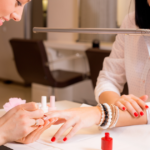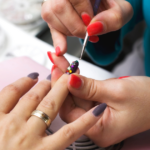A nail technician is skilled in the techniques of cleaning, filing and grooming fingernails and toenails, also known as manicures and pedicures. Nail techs also trim and remove the cuticle, which is that small flap at the base of the fingernail, as well as moisturize the hands and feet, remove dead skin in both areas and finish with a massage for relaxation and to improve blood circulation.

Nail techs can also apply acrylic nails, gel coverings, or a silk strengthener. These treatments can be followed with a layer of polish, a French manicure or a decorative airbrush design can be applied. Small jewelry and decals are also available as decorative touches if the client desires.
Nail technicians are typically extroverts – outward and friendly professionals at ease with customers and advising them on their needs.
You can find work in this lucrative career at beauty spas and salons, and studios dedicated solely to nail treatments. Going into business for yourself is also an option.
This is creative and fun work for the outgoing professional who enjoys interacting with people. If this sounds like you, read on to learn how you can get ready to work as a nail tech.
In this article you’ll learn:
- How much money you can make as a nail tech
- The required training and certifications
- Professional groups to join
- Employment opportunities for nail techs
- Finding clients
- Plus helpful tips

How much money can you make?
Nail techs average $25,770 per year, according to the US Bureau of Labor Statistics. That works out to $12.39 an hour, based on a 40-hour work week.
Employment of manicurists and pedicurists is projected to grow 10 percent through 2028, faster than the average for all occupations, the bureau reports. New types of nail services, such as mini-sessions and mobile manicures and pedicures, will likely drive employment growth.
If you operate your own nail salon with employees, you can earn much more. The different types of compensation packages typically offered to nail techs are covered in detail under the Employment section.
Training and Certification
Manicurists and pedicurists must complete a state-approved cosmetology or nail technician program and then pass a state exam for licensure, which is required in all states except Connecticut.
Here is a comprehensive state-by-state guide to licensing requirements for nail techs so you can quickly determine what regulations will apply where you live.
Once you know what must be done to qualify for licensure in your state, you’ll be prepared to find a training program that fulfills those requirements. Here’s a guide to nail tech schools and training programs to get you started in your research.
What you’ll learn in training:
- Skeletal, macular and skin issues that affect people’s nails
- How to help clients achieve good nail health
- Sanitation and sterilization methods
- The structure of the nail, as well as the anatomy of the foot and the hand
- Applying nail decorations
- Nail removal and enhancement
- Working with artificial nails
Professional Groups to Join
Getting involved with a professional organization shows dedication to your career and craft. These memberships can be displayed at your nail salon and noted on your website, which enhances your credibility in the eyes of potential customers. Plus, belonging to a professional group lets you network with others in your field, exchange ideas and find out about job openings – often before they’re advertised to the general public. Here are some of the top groups for nail techs:
National Cosmetology Association
The National Cosmetology Association, now under the auspices of the Professional Beauty Association (PBA), is a trade organization committed to supporting licensed salon professionals in their careers while striking a healthy balance between their professional and personal lives.
Any licensed professional, whether working for a salon or as an independent contractor, is eligible to join PBA. The PBA | NCA licensed professional section also welcomes currently enrolled cosmetology students.
Associated Nail Professionals
Since 1987 this association has served expert nail professionals. Membership is $199 a year and comes with these benefits:
- Professional liability insurance
- Free subscription to NAILS or VietSALON magazine
- Money-saving discounts
- Your own website

NAILS Association
N.A.I.L.S. Association’s mission is to connect, unite, and empower nail technicians all over the world. They strive to be a unified voice for working nail professionals, regulators, manufacturers, and consumers.
One global nail family, working together to improve the professional nail services industry, while fostering the industry culture of inclusion and affordable professional education.
International Nail Technicians Association
The International Nail Technicians Association (INTA) helps nail technicians grow professionally through expert education, networking opportunities, valuable information about fashion, trends & techniques and standards and ethics guidelines. They are the voice of the nail care industry. INTA membership is $130 for licensed nail technicians.
Employment
Nail technicians usually work at a nail salon with other nail techs. The salon features several manicure and pedicure stations, and it is customary for each nail tech working at the salon to rent a station. This fee can either be a set amount every month or a percentage of what the nail technician earns. With this arrangement, nail techs are responsible for marketing to their own clients. Nail techs can also work at a spa, hairdressing salon, or from home.

Before applying for these jobs, it’s a good idea to print copies of your resume, license, training certifications and any other documents that present you in the most favorable professional light. You can create a simple portfolio of 3-4 pages stapled together illustrating examples of your work.
If you’re just starting out, it may not be financially practical to open your own studio right away. Besides visiting the salons and spas in your area, online job-search services such as Indeed.com and ZipRecruiter will yield openings.
Join nail tech groups on social media so you can build your professional network. Set up your professional profile on LinkedIn to start connecting with other makeup artists and groups whose members may know about upcoming job openings before they’re advertised.
Spas and nail salons can compensate employees in different ways. Here’s what you will most likely encounter:
Hourly Pay + Commission
Many salons and spas pay their nail techs a low hourly wage plus commission, which is based on a percentage of how much business you produce. So if you delivered $1,000 worth of services to clients and receive a 20% commission, you’d put $200 in your pocket plus your pre-arranged hourly wage.
Team Member Compensation
With this arrangement, you are paid a base salary plus commissions on your services and any products you sell to clients. If salesmanship is a skill you possess or are willing to learn, this compensation package might be right for you. If you learn only one sales technique, this is it: Don’t ask clients what beauty products they might like to buy. Instead, show them the products they need to buy and explain why.
Straight Salary
You earn a salary and possibly receive benefits like health insurance and paid vacation time. Straight salary jobs are usually found in professional settings such as medical spas.
Finding Clients
When running your own nail tech business, an attractive website needs to be the first item in your marketing arsenal. It is, in fact, the professional face of your business that potential new clients will probably encounter first. If you’re not comfortable designing a website yourself using templates and artwork from popular sites like WordPress, hire someone to build a website for you. It does not need to be fancy, just pleasing to the eye. Get an online presence going and keep it up-to-date with photos and occasional special offers to drive traffic to your door, discounts for new customers, maybe even a price break for existing clients who refer new customers to you.

Join Instagram and Facebook, and create a page on each site specifically for your nail tech business. It’s free and gets you out there in front of millions of people. Post pictures of your work, especially before and after photos. Always get permission from your clients to post their pictures online, unless you’re using extreme close-up shots of their hands and feet only.
Build your credibility with online reviews. According to a recent survey, 90% of participants are influenced by positive online reviews. Ask happy clients to post a review for you.
Have all new customers fill out a basic form about their interest in your services and be sure they include their contact information. Your web site can be set up to require contact information before the form can be submitted. You want contact information so you can follow-up with all your clients. This encourages repeat business.
Good to know
Bacterial, viral and fungal infections are the single greatest threat to the success of your career as a nail tech. If someone gets an infection as a result of visiting your salon, there is a significant chance you will never see that customer again.

Podiatrist Dr. Robert Spalding, author of “Death by Pedicure,” writes that “at this time, an estimated one million unsuspecting clients walk out of their chosen salon with infections.” Spalding claims his research shows “75 percent of salons in the United States are not following their own state protocols for disinfections,” including not preparing their disinfectant solutions properly, not soaking their instruments appropriately, and using cheaper products to cut costs (such as substituting a generic glass cleaner for Barbicide).
The solution is to clean your workstation and all equipment thoroughly and by the book at the end of every work day. You will also be wise to clean in-between clients when using the same tools on multiple individuals throughout the day. This protects you and your customer, while preserving your business reputation. Don’t take chances when sanitizing tools and equipment.
If you enjoyed this article, check out some more great PocketSuite.io content that can help you grow your career as a nail tech. Here’s a great place to start.
PocketSuite has thousands of business owners who all started where you are right now. Our community is always happy to help you ramp up, grow your client base, and achieve your income goals, both within the PocketSuite app and as part of our exclusive Facebook Community Group. PocketSuite’s vision is for any professional to be able to work for themselves and make a great living. It starts here. It starts with you. It starts today. Let’s get started, download PocketSuite now! Feel free to reach out with any questions (we’d love to hear from you)! Text us @ (415) 841-2300.





